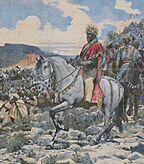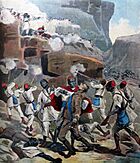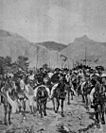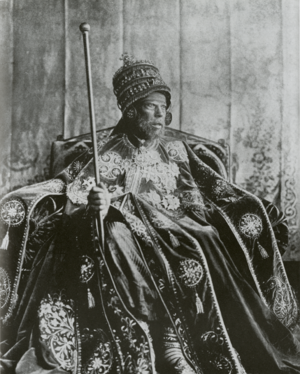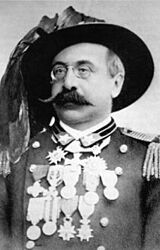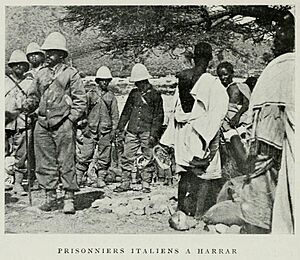First Italo-Ethiopian War facts for kids
Quick facts for kids First Italo-Ethiopian War |
|||||||||
|---|---|---|---|---|---|---|---|---|---|
| Part of the Scramble for Africa | |||||||||
|
|
|||||||||
|
|||||||||
| Belligerents | |||||||||
| Kingdom of Italy | Ethiopian Empire | ||||||||
| Commanders and leaders | |||||||||
| Francesco Crispi Oreste Baratieri Giuseppe Arimondi † Giuseppe Galliano † Pietro Toselli † |
Menelik II Taytu Betul Mengesha Yohannes Welle Betul |
||||||||
| Strength | |||||||||
| 35,000–43,700 | 80,000–125,000 | ||||||||
| Casualties and losses | |||||||||
| 9,313 killed 1,428 wounded 3,865 captured |
~10,000 killed | ||||||||
The First Italo-Ethiopian War was a conflict between Italy and Ethiopia from 1895 to 1896. It is also known as the First Italo-Abyssinian War. The war started because of a disagreement over the Treaty of Wuchale. Italy believed this treaty made Ethiopia its protectorate (a country controlled and protected by another).
However, the Ethiopian version of the treaty said something different. Full-scale war began in 1895. Italian troops from Italian Eritrea won some early battles. But then, a large Ethiopian army led by Emperor Menelik II joined the fight. The war ended with a major Ethiopian victory at the Battle of Adwa. This battle forced the Italian soldiers to retreat back to Eritrea. The war finished with the Treaty of Addis Ababa. This victory was very important. It was one of the first times an African army decisively defeated a European colonial power. It showed that Ethiopia could remain an independent nation.
Why the War Started
European Powers and Ethiopia
In the late 1800s, European countries were trying to take control of parts of Africa. This period is called the Scramble for Africa. Egypt had taken over Eritrea, a region next to Ethiopia. Egypt then tried to conquer Ethiopia but failed.
Later, Egypt faced problems and started to leave Eritrea. Britain, a powerful European nation, didn't want France to take over Eritrea. So, Britain encouraged Italy to move into the area instead. In 1885, Italian troops landed in Massawa, a port city in Eritrea.
Italy had recently become a united country. Many Italians were poor and unhappy. The government hoped that gaining colonies would make people feel proud. They wanted to build a "second Roman empire."
The Battle of Dogali
Ethiopia's Emperor Yohannes IV fought against the Italians. In 1887, a battle happened at Dogali. An Italian force was ambushed by Ethiopian soldiers. The Ethiopians, led by Ras Alula, surrounded the Italians. After running out of ammunition, the Italians were defeated. This loss made Italy more careful for a while.
Menelik II Becomes Emperor
In 1889, Emperor Yohannes IV died. Menelik II, a powerful ruler from the Shewa region, became the new Emperor of Ethiopia. Some Ethiopian nobles were unhappy with this change. For a short time, one noble, Ras Mengesha, even allied with the Italians. But most Ethiopians eventually united behind Emperor Menelik.
The Treaty of Wuchale Dispute
On May 2, 1889, Emperor Menelik II signed the Treaty of Wuchale with Italy. This treaty was supposed to give Italy control over Eritrea. In return, Italy recognized Menelik's rule and provided money and weapons.
However, there was a big problem. The treaty was written in two languages: Italian and Amharic (Ethiopia's language). The two versions said different things. The Italian text stated that Ethiopia must conduct its foreign affairs through Italy. This would make Ethiopia an Italian protectorate. But the Amharic version said Ethiopia could contact foreign powers using Italy's embassy. This meant Ethiopia still had a choice.
Italian diplomats told other European countries that Ethiopia was now their protectorate. Most European nations accepted this claim. But Emperor Menelik was shocked when he learned what the Italian version implied. He had not agreed to give up Ethiopia's independence.
Ethiopia Prepares for War
Francesco Crispi, the Italian Prime Minister, wanted to build a large colonial empire. He believed Ethiopia was the perfect place to start. Because Menelik refused to accept the Italian version of the treaty, Italy decided to use military force. They thought they could win easily by using their advanced technology.
However, Menelik had spent years building up Ethiopia's army. He bought modern weapons and ammunition from different countries. He got rifles and artillery from Russia, France, Britain, and even Italy at first. By 1894, Ethiopia had many modern rifles and cannons.
In 1893, Menelik officially rejected the Treaty of Wuchale. Italy responded by taking over small areas near their border. Finally, in December 1894, Italy launched a military campaign into the Tigray region of Ethiopia. Italy hoped that some Ethiopian leaders would join them. But instead, almost all Ethiopians united behind Emperor Menelik. They wanted to protect their country's freedom.
Russia was Ethiopia's only European ally. In 1895, Ethiopia sent its first diplomatic mission to Russia. Russia sent weapons and ammunition to Ethiopia. Russian travelers also wrote about Ethiopia, saying Ethiopians were deeply religious and culturally advanced, like the Russians.
The War Begins
In December 1894, a local leader named Bahta Hagos led a rebellion against the Italians. Italian forces, led by Major Pietro Toselli, quickly crushed the rebellion. General Oreste Baratieri, the Italian commander, suspected that another Ethiopian leader, Ras Mengesha, would invade Eritrea. Baratieri's forces defeated Mengesha in two battles in January 1895.
Baratieri then marched into the Tigray region of Ethiopia. He announced that Tigray was now part of Italian Eritrea. At this point, Emperor Menelik asked France for help. But France chose to support Italy instead, to gain Italy's approval for their control of Tunisia.
So, Emperor Menelik was largely on his own. On September 17, 1895, he called on all Ethiopian men to join his army. Leaders from every part of Ethiopia answered his call. They gathered an army of over 100,000 men. This huge army then marched north to face the Italian invaders.
Battle of Amba Alagi
The next major fight happened at Amba Alagi on December 7, 1895. Ras Makonnen, a key Ethiopian general, led his army to Amba Alagi. They faced Major Toselli and about 2,000 Italian and Eritrean soldiers. Makonnen, joined by Ras Mengesha and Welle Betul, attacked the Italian positions. They defeated the Italians, and Major Toselli was killed.
General Giuseppe Arimondi, who was bringing reinforcements, barely escaped. He retreated with 400 survivors to an unfinished Italian fort at Mekelle. Arimondi left about 1,350 soldiers at Mekelle, led by Major Giuseppe Galliano. He then took the rest of his troops to Adigrat, where General Baratieri was gathering the main Italian army.
Siege of Mekelle Fort
Ethiopian troops reached Mekelle a few days later. Ras Makonnen surrounded the fort on December 18. By early January 1896, Emperor Menelik II and his wife, Queen Taytu Betul, arrived with their massive army.
Menelik offered the Italian commander a chance to leave peacefully. The commander refused until the Ethiopians cut off the fort's water supply. On January 21, the Italians surrendered. Menelik allowed them to leave Mekelle with their weapons. He even gave them mules and pack animals to rejoin Baratieri's army. This generous act was also a smart move. It allowed Menelik to position his army in a strong defensive location near Adwa.
Menelik decided not to attack the main Italian headquarters at Adigrat. Instead, he marched west towards the plateau of Adwa. Baratieri feared that Menelik planned to invade Eritrea. So, he left Adigrat and moved his troops towards Adwa. On February 28, 1896, Baratieri met with his generals. He told them their supplies were running low. He asked if they should retreat or attack Menelik's army. All his generals wanted to attack. Baratieri decided to try a surprise attack the next day.
The Battle of Adwa
The most important battle of the war was the Battle of Adwa on March 1, 1896. It took place in the mountains north of Adwa. The Italian army had about 17,700 men and 56 cannons. The Ethiopian army was much larger, with 73,000 to 120,000 men. Many Ethiopians had modern rifles and almost 50 cannons.
General Baratieri had underestimated the size of the Ethiopian army. He thought Menelik only had 30,000 men. Also, the Ethiopians had better weapons. They had thousands of modern rifles and Hotchkiss artillery guns. These were superior to the Italian weapons. Menelik had also made sure his soldiers were well-trained to use these new weapons. The Hotchkiss artillery could fire much faster than the Italian cannons.
On the night of February 29 and early morning of March 1, three Italian brigades advanced separately. They moved over narrow mountain paths towards Adwa. A fourth brigade stayed in camp. The three leading brigades got separated during their march. By dawn, they were spread out over several miles of difficult land.
General Baratieri did not know that Emperor Menelik had planned to move his camp the next day. Menelik had risen early when his spies brought news that the Italians were advancing. The Emperor quickly gathered his nobles' armies. With Empress Taytu Betul by his side, he ordered his forces to attack.
The Italian forces were hit by wave after wave of Ethiopian attacks. Menelik then sent in his reserve force of 25,000 men. This large force quickly overwhelmed one Italian brigade. Another brigade was cut off and destroyed by an Ethiopian cavalry charge. The last two Italian brigades were also defeated. By noon, the remaining Italian soldiers were in full retreat.
The Battle of Adwa was a huge defeat for Italy. About 6,133 Italian soldiers were killed or went missing. Another 1,428 were wounded. Around 2,865 Italian and Eritrean soldiers were taken prisoner. The Ethiopians lost about 7,000 killed and 10,000 wounded. As they fled, the Italians left behind all their cannons and 11,000 rifles.
What Happened Next
Peace and Independence
News of the Italian defeat quickly reached Italy and the world. Italy was shocked. Riots broke out in several Italian cities. Within two weeks, Prime Minister Crispi was forced to resign. Italians were very unhappy with their country's "foreign adventures."
After the battle, Emperor Menelik II sent a message to the Italian commander. He said he would make peace if Italy publicly gave up its claim to be Ethiopia's protectorate. The Italians eventually agreed to this. In October, Menelik signed the Treaty of Addis Ababa. This treaty set the borders of Eritrea. Most importantly, it forced Italy to recognize Ethiopia's independence "absolutely and without any reserve."
Ethiopia's New Status
Ethiopia's victory greatly increased its standing in the world. Other European powers quickly changed how they dealt with the Ethiopian Empire. Delegations from Britain and France, whose colonies were next to Ethiopia, soon arrived in the Ethiopian capital. They wanted to negotiate their own treaties with this powerful nation.
French influence in Ethiopia grew a lot after the Italian defeat. France became one of the most important European powers in Menelik's court. Russia also gained prestige because it had supported Ethiopia.
In 1935, Italy tried to invade Ethiopia again in the Second Italo-Ethiopian War. This time, Italy won and took control of Ethiopia. However, Italy was driven out in 1941 during World War II by Ethiopian patriots and British forces.
Gallery
See also
- Ethiopia–Italy relations
- Italo-Ethiopian War of 1887–1889
- Second Italo-Ethiopian War
- Italian Empire
- Military history of Ethiopia
- Military history of Italy


